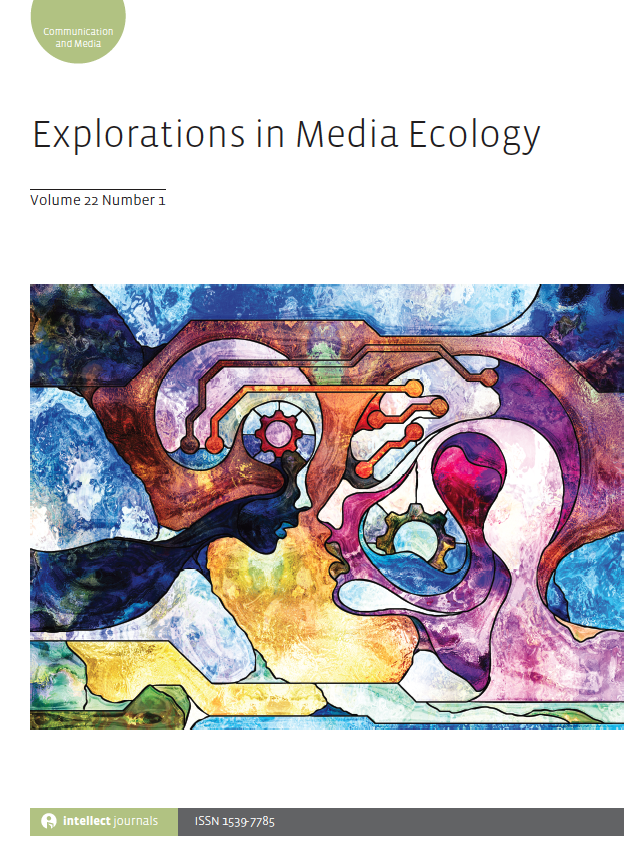- Home
- A-Z Publications
- Explorations in Media Ecology
- Previous Issues
- Volume 4, Issue 1, 2005
Explorations in Media Ecology - Volume 4, Issue 1, 2005
Volume 4, Issue 1, 2005
-
-
The Computational Mind and the Digitized Society: A Question of Rules
More LessAbstractInformation technology has allowed us to organize and coordinate actions to a degree unimaginable even a few decades ago—think of the man on the moon program— and to understand the rational workings of the human mind—think of Chomsky’s account of language as the product of rules and representations. I examine both of these ventures in terms of the increasing rationality of thought and action and the increasing rationality of social organization—the attempt to make both subject to explicit rules. I begin by commenting briefly on five domains where rules have a conspicuous place before advancing my arguments connecting rules, whether psychological or social, and literacy.
-
-
-
From Pet-Making to High-Tech: Exploring the Dog‘s Role in the Media Environment
More LessBy Ellen RoseAbstractThe purpose of this article is to broaden the media ecology perspective by considering the role of another creature, the dog, within the media environment. It is argued that the dog does not exist outside the media environment but is in fact a vital part its ecology. Its roles are formative (the dog’s presence in prehistoric human communities was arguably a precondition for the emergence of media and technology), compensatory (the dog’s presence helps us tolerate life in technological society), and moral (the dog communicates information about who we are as ethical beings that becomes vital in a society increasingly dominated by amoral technological imperatives). An acknowledgment of the dog’s roles is offered as a necessary step toward a truly ecological understanding of the nature and quality of interactions—both human and non-human—within the media environment.
-
-
-
Ghosts in the Medium: The Haunting of Heidegger‘s Technological Question
More LessBy Kenneth RufoAbstractIn an attempt to orient media ecology along a slightly different trajectory, this article expands the consideration of the medium by looking to its triple promise as a technology, a psychic medium, and in-between. This article blends together two seeming disparate case studies—Rudyard Kipling's early take on wireless telegraphy (today thought in terms of radio) and Martin Heidegger's discussion of language and technics—in order to demonstrate how media “haunt” many of our “discussions” of technology. Turning to Jacques Derrida, who has long been concerned with mediation, this article attempts to interrogate Heidegger on behalf of Kipling’s radio, in order to see how the medium upsets the basic binary of language/ technology, and to explore how mediation dissolves the philosophical presumption of presence. At the same time, this article argues that philosophers like Heidegger confront this dissolution with a rhetorical trick still popular today: the linking of past media ecologies to a more stable, more authentic spiritual component, a technostalgia that attempts to exorcize today's “ghosts in the medium.”
-
-
-
How to Hear a Film
More LessAbstractThis article explores the expressiveness, the biases and the limitations of the visual and aural modalities and examines the ways sound and visual images may be joined to create meanings in the cinema. The focus is on meanings that could not be made or carried by the visual image alone. The piece provides an interpretive approach to cinema that is based in the filmmakers’ intentions and offers some criteria for judging the aesthetic value and success of the sound track. The author presents brief analyses of American commercial films to serve as examples of skillful and original sound–image relationships.
-
-
-
The Practice of Reading Good Books: A Plea to Teachers and Students
More LessBy Corey AntonAbstractThis article is designed to provoke lively discussion between and among teachers and students regarding the growing state of reading atrophy. It best serves as an “inspirational” beginning piece for undergraduate humanities or social science courses that contain difficult, “primary source,” readings. The article consists of two main parts. The first addresses contemporary sources of reading atrophy. The second part offers arguments for why the practice of reading difficult books is worth the effort.
-
-
-
Reviews
More LessAuthors: Stephanie Bennett, Jessica Knapp and Phillip RoseAbstractStrate, Lance, Ron L. Jacobson, and Stephanie Gibson, eds. Communication and Cyberspace: Social Interaction in an Electronic Environment (2nd ed.). Cresskill, NJ: Hampton Press, 2003. 416 pp. Paper $34.50, ISBN 1-57273-394-2.
Starr, Paul. The Creation of the Media: Political Origins of Modern Communications. New York: Basic Books, 2004. 448 pp. Cloth $27.50, ISBN 0-465-08193-2.
Albrecht, Robert. Mediating the Muse: A Communications Approach to Music, Media and Culture Change. Cresskill, NJ: Hampton Press, 2004. 450 pp. Paper $35.00, ISBN 1-57273-511.2
-
Volumes & issues
-
Volume 22 (2023)
-
Volume 21 (2022)
-
Volume 20 (2021)
-
Volume 19 (2020)
-
Volume 18 (2019)
-
Volume 17 (2018)
-
Volume 16 (2017)
-
Volume 15 (2016)
-
Volume 14 (2015)
-
Volume 13 (2014)
-
Volume 12 (2013)
-
Volume 11 (2012)
-
Volume 10 (2011)
-
Volume 9 (2010)
-
Volume 8 (2009)
-
Volume 7 (2008)
-
Volume 6 (2007)
-
Volume 5 (2006)
-
Volume 4 (2005)
-
Volume 3 (2004)
-
Volume 2 (2003)
-
Volume 1 (2002)
Most Read This Month


